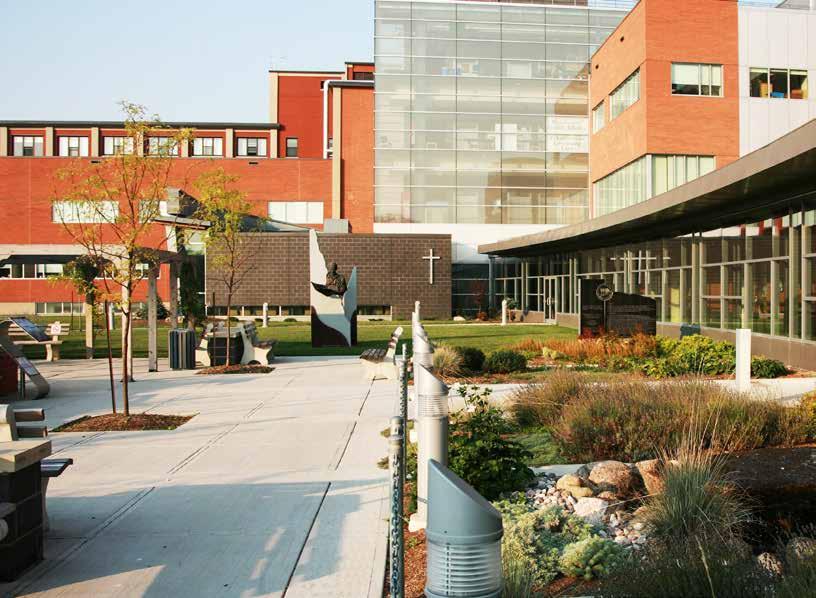
4 minute read
Let’s ‘Dew’ It
from CHF Fall 2020
by MediaEdge
Desiccant dehumidification technology allows critical spaces to operate at lower temperatures ideal for patient health
By John Gowing
The facility management team at Chatham-Kent Health Alliance (CKHA) has a reputation for its progressive approach to continuous building renewal. The 200-plus bed hospital has undertaken numerous updates, some of which were completed through a program driven by utility savings. The latest initiative addressed the lack of control over high humidity in both the surgical suites and medical device reprocessing department (MDRD).
RISING TO THE CHALLENGE
Today’s surgical teams are required to wear heavy protective gowning. As a result, lower space temperatures are preferred. At the same time, some medical procedures require a lower ambient temperature in order to lessen the patient’s metabolic rate and help prepare for a safer surgery. These reduced temperatures demand lower dew points to keep moisture away from critical surfaces and maintain relative humidity in an operating range acceptable for essential services.
CKHA’s then-manager of engineering services, Harrie Bos, was familiar with desiccant dehumidification technology and some of its successful humidity control projects in surgical suites. He consulted the hospital’s moisture control specialist about CKHA’s high humidity challenges. Throughout most of the season, the facility’s chilled water systems were capable of producing a low temperature fluid, allowing critical spaces to maintain tolerable humidity and temperature specifications; however, during
peak summer humidity periods, the air handling units (AHUs) were challenged to maintain acceptable relative humidity levels when lower space temperatures are preferred. As discussion and research continued, a decision was made to separate the endoscopy suite from the other operating room (OR) suites.
The endoscopy system redesign provided an excellent opportunity to evaluate and measure the impact of humidity control with desiccant dehumidification technology. The successful humidity control in the endoscopy suites formed a solid internal reference (or talking) point for future meetings about the remaining systems.
CONTROLLING FOR HUMIDITY
To advance the dehumidification project, the facility operators hosted a meeting with management from both surgery and MDRD. Attending individuals were interested to hear that the technology used to control humidity in the endoscopy suites could provide the same control in these areas.
Following a chiller disruption and the resulting interruption to essential services, funding for the desiccant dehumidification systems for the surgical suites and MDRD was fast-tracked. Three identical units were installed, all designed to pre-condition and dehumidify outdoor air to an ideal low dew point level. A single unit supplies dry ventilation air to the MDRD AHU, while the other two supply dry air to the existing OR AHU. The cooling coils inside the existing AHUs are no longer required to sub-cool and dehumidify ventilation air. Essentially, the cooling capacity requirements for the existing coils are significantly reduced.
Previously, the chiller plant’s lowest fluid operating temperatures were dictated by the two critical spaces (OR and MDRD). However, with the installation of the desiccant dehumidification units, chilled water supply temperature can be raised while improving both chiller capacity and efficiency. Recognizing the
desiccant units are performing all the latent work (dehumidification), the existing AHUs now have a single task of conditioning the space sensible (dry-bulb temperature) load requirements. De-coupling the existing cooling coils from having to perform both sensible and latent work significantly reduces the reheat energy requirements for the OR suites.
REAPING THE REWARDS
The dehumidification systems used at CKHA yield some of the highest moisture removal efficiency levels in the industry. The direct expansion system utilizes both the cooling energy from the compressor and the heat-reclaim to regenerate the desiccant rotor (exceeding the criteria of ASHRAE 90.1, Energy Standard for Buildings Except Low-Rise Residential Buildings). Building operators bring the new dehumidification systems online whenever the outdoor ambient conditions rise above 5 C, ensuring the critical spaces will always maintain the required low dew points.
Preliminary results of controlling space humidity in the critical areas with the new dehumidification technology are very promising. For the first time, the affected OR suites are able to maintain 50 per cent relative humidity at critically lower space temperatures ranging between 18 C and 20 C.
James Woodall, who succeeded Bos as CKHA’s manager of engineering services upon his retirement, has already recognized some additional merits of the installation. During a brief interruption in the chiller’s operation, he discovered the desiccant dehumidification units continued to maintain humidity control in the critical spaces. This allowed space temperatures to be quickly reestablished once the chiller operation was restored.
Managers are pleased they are no longer seeing interrupted procedure hours that were the result of high humidity.
“Patient safety is our number one priority and with the installation of the units, we have been able to accurately control humidity levels in the department, limiting risk and eliminating the need to delay surgical procedures and instrument processing,” says MDRD manager, Tina Cousineau.
As the technology becomes more familiar to the facility operators, there will be additional saving opportunities during shoulder months — the chillers can be off while the desiccant dehumidification units continue to dehumidify the air.
What’s more, this project puts CKHA in a leadership role amongst its peers in the province, specifically when it comes to efficient and successful humidity control in critical spaces.








